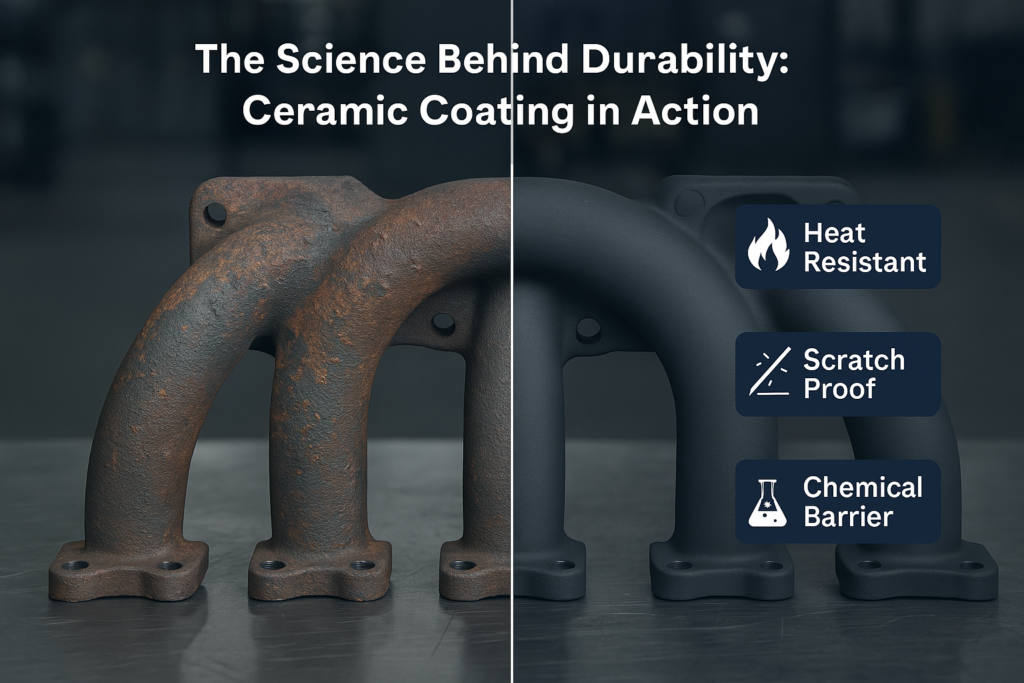-
×
Blue Flame C-158 - Pint 473ml (16oz)
- size:
Pint 473ml (16oz)
1 × €90.00 -
×
CERAKOTE® In-Cup 100 Mesh Strainer (150 Micron) SE-275
1 × €39.95
Subtotale: €129.95

Ceramic coatings are trusted across automotive, aerospace, defense, and industrial sectors for one key reason: exceptional durability. But what gives these ultra-thin coatings the ability to withstand heat, abrasion, corrosion, and chemicals—often outperforming thicker, traditional alternatives?
At Cerakote, we work with cutting-edge ceramic coating technologies that leverage material science and nanotechnology to deliver industry-leading performance. Let’s break down the science behind their durability.
Ceramic coatings are typically composed of ceramic-based polymers such as:
These compounds are formulated to chemically bond with the substrate, forming a dense, cross-linked molecular structure that enhances mechanical and chemical resistance.
Unlike traditional paints or waxes that sit on the surface, ceramic coatings chemically bond at the molecular level with the material.
✅ This creates a permanent barrier that resists wear and degradation.
✅ It also makes the coating incredibly hard to remove or chip under stress.
Many ceramic coatings rate 9H on the pencil hardness scale, making them among the hardest coatings available.
✅ This hardness protects against scratches, impacts, and abrasion.
✅ It also prevents micro-marring from routine cleaning or environmental exposure.
Ceramic coatings are engineered to resist extreme heat, often up to 980°C (1,800°F).
✅ This makes them ideal for engine parts, exhausts, turbines, and firearms.
✅ High heat tolerance ensures long-term stability and no breakdown under thermal cycling.
The molecular structure of ceramic coatings makes them impervious to most chemicals and resistant to oxidation and corrosion.
✅ Protects metal surfaces from moisture, salt, solvents, acids, and fuel.
✅ Ideal for harsh industrial environments, marine exposure, and chemical processing.
Ceramic coatings repel water and contaminants thanks to their low surface energy.
✅ Prevents buildup of dirt, oil, and grime.
✅ Reduces cleaning time and preserves the coated surface.
✅ Helps resist UV oxidation and fading on exterior components.
Durability isn’t just about hardness—it’s also about flexibility.
✅ Ceramic coatings maintain strong adhesion to substrates and resist cracking or flaking, even under vibration, expansion, or stress.
✅ Ideal for moving parts or complex geometries.
At Cerakote, we see durability proven daily in applications like:
Durability isn’t a marketing term—it’s a tested, measurable benefit of ceramic science in action.
The durability of ceramic coatings comes from their molecular structure, heat stability, surface hardness, and chemical resistance. With unmatched performance in harsh, high-stress environments, ceramic coatings offer long-lasting protection with minimal maintenance.
Want to see how durable ceramic coatings can transform your project?
Contact the CerakoteEU team today to discuss your coating needs.